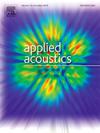Vibration and noise reduction characteristics of double-layer stiffened plates embedded with acoustic black holes
IF 3.4
2区 物理与天体物理
Q1 ACOUSTICS
引用次数: 0
Abstract
The double-layer stiffened plates are often adopted in vehicles since stronger load-bearing capacity. However, the structural complexity causes challenges for enhancing the performance of reducing vibration and noise. To address these challenges, this study introduces the acoustic black hole (ABH) and periodic structure into double-layer stiffened plates based on the theory and method of elastic wave propagation and control. Firstly, the finite element model of ABH embedded in the periodic double-layer stiffened plate is established and then the band gap is calculated and analyzed to clarify the wave propagation characteristics in the structure. On this basis, the vibration suppression mechanism of ABH is illustrated through interface response and vibration cloud maps. Furthermore, the sound-structure coupling simulation model is established to study the influence of ABH on sound radiation by integrating the vibro-acoustic theory. And the noise reduction performance of periodic double-layer stiffened plates by ABH is also investigated through coupling coefficients and power flow analysis, etc. At last, the vibration and sound radiation experimental investigation are performed to validate the simulation results. This research contributes to the application of ABH in various transportation vehicles, the research of the vibration and noise reduction as well as the optimization design of double-layer stiffened plates.
嵌入声黑洞双层加筋板的减振降噪特性
由于双层加筋板的承载能力更强,因此车辆常采用双层加筋板。然而,结构的复杂性给提高减振降噪性能带来了挑战。为了解决这些问题,本研究基于弹性波传播与控制的理论和方法,将声黑洞和周期结构引入双层加筋板中。首先建立了周期双层加筋板中嵌入ABH的有限元模型,然后对其带隙进行了计算和分析,明确了波在结构中的传播特性。在此基础上,通过界面响应和振动云图说明了ABH的减振机理。在此基础上,结合振动声理论,建立了声-结构耦合仿真模型,研究了ABH对声辐射的影响。并通过耦合系数和潮流分析等方法研究了ABH周期性双层加筋板的降噪性能。最后进行了振动声辐射实验研究,验证了仿真结果。本研究为ABH在各种运输车辆上的应用、减振降噪的研究以及双层加筋板的优化设计提供了理论依据。
本文章由计算机程序翻译,如有差异,请以英文原文为准。
求助全文
约1分钟内获得全文
求助全文
来源期刊

Applied Acoustics
物理-声学
CiteScore
7.40
自引率
11.80%
发文量
618
审稿时长
7.5 months
期刊介绍:
Since its launch in 1968, Applied Acoustics has been publishing high quality research papers providing state-of-the-art coverage of research findings for engineers and scientists involved in applications of acoustics in the widest sense.
Applied Acoustics looks not only at recent developments in the understanding of acoustics but also at ways of exploiting that understanding. The Journal aims to encourage the exchange of practical experience through publication and in so doing creates a fund of technological information that can be used for solving related problems. The presentation of information in graphical or tabular form is especially encouraged. If a report of a mathematical development is a necessary part of a paper it is important to ensure that it is there only as an integral part of a practical solution to a problem and is supported by data. Applied Acoustics encourages the exchange of practical experience in the following ways: • Complete Papers • Short Technical Notes • Review Articles; and thereby provides a wealth of technological information that can be used to solve related problems.
Manuscripts that address all fields of applications of acoustics ranging from medicine and NDT to the environment and buildings are welcome.
 求助内容:
求助内容: 应助结果提醒方式:
应助结果提醒方式:


